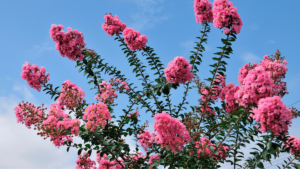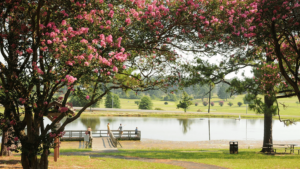Crape Myrtle Pruning
Pruning is one of the simplest yet most impactful ways to ensure your plants thrive and look their best. Done correctly, it enhances plant health, prevents overgrowth, and adds aesthetic value to your landscape. But improper pruning? It can spell disaster, especially for Crape myrtles, which are often victims of a common landscaping sin dubbed “Crape Murder.”
What is “Crape Murder”? It’s the practice of severely chopping back Crape myrtles every year, leaving them stubby and struggling. This blog is here to set the record straight. We’ll walk you through proper pruning techniques for Crape myrtles and other plants like roses, hydrangeas, ornamental grasses, and perennials. We’ll also dive into the cost-effective benefits of doing it right versus the expensive fixes of neglect. Let’s make pruning a joy, not a crime!
Understanding Crape myrtles
Crape myrtles are beloved for their show-stopping blooms and elegant structure, but improper pruning can quickly turn them into unsightly stubs. Here’s why proper pruning is essential:
Health and Structure: Over-pruning weakens the tree and invites pests and disease.
Aesthetic Value: A well-pruned Crape myrtle retains its natural beauty and shape.
The Dangers of Hard Pruning
Overly hard pruning, also known as “topping,” removes large sections of the tree and leads to:
- Weak, spindly regrowth.
- Increased susceptibility to pests like aphids and lace bugs.
- Reduced flowering potential.
When is a Hard Prune Necessary
Sometimes, a hard prune is unavoidable, especially when crape myrtles outgrow their space or begin encroaching on buildings. If this becomes necessary, be sure to cut with care by leaving strong, healthy branches intact to support regrowth. Growth regulators can also be a practical solution for managing the size of trees that have become too large without resorting to drastic cuts.
With dozens of crape myrtle species available—ranging from dwarf to medium to large varieties—selecting the right type for your landscape from the start is key to avoiding these issues. Think of it like choosing a puppy: if you’re not prepared for the commitment of a big dog, don’t get one. For personalized advice and solutions, consult the experts at Puryear Farms.
Preventative Care and Expert Support
The best way to avoid hard pruning is through preventative care, such as regular and thoughtful maintenance. This approach is far more cost-effective than addressing years of overgrowth and ensures the long-term health and beauty of your crape myrtles. By investing in professional pruning services, you save money, preserve your trees, and enhance your landscape.
At Puryear Farms, we specialize in crape myrtle care and can guide you in choosing the right variety for your space. Contact us today to keep your crape myrtles thriving and prevent costly damage from improper pruning.
Proper Pruning Techniques for Crape myrtles
Pruning Crape Myrtles correctly is essential for maintaining their health, structure, and vibrant blooms. Follow these best practices for optimal results:
Timing: The ideal time to prune Crape myrtles is late winter to early spring, before new growth begins. This allows you to shape the tree before the onset of the growing season, minimizing stress on the plant.
Tools: Always use sharp pruning shears and loppers to make clean, precise cuts. Dull tools can damage the branches and lead to disease entry points. For larger branches, consider using a pruning saw to ensure a smooth cut.
Technique:
- Remove dead or damaged wood: Start by cutting out any dead, diseased, or broken branches to prevent pest infestations and diseases.
- Thin out overcrowded areas: Prune areas where branches are crossing or congested, allowing better air circulation and light penetration to the interior of the tree. This helps prevent fungal diseases and promotes healthy growth.
- Avoid cutting back to stubs: Never prune back too aggressively or cut branches down to stubs. Instead, prune just above a healthy bud or lateral branch to encourage natural growth patterns and maintain the tree’s shape.
By following these techniques, you ensure a healthier, more beautiful Crape myrtle that will bloom more profusely and resist pests and diseases. Proper pruning also promotes long-term structural integrity and reduces the need for costly corrective maintenance.

Protecting Against Pests
If your crape myrtles are covered in a black, sooty substance, they’re likely battling aphids, lace bugs or whiteflies, which excrete a sticky sugary liquid called honeydew that fosters mold growth. At Puryear Farms, our technicians are trained to spot these early signs and know exactly what to look out for.
If we notice pest activity, our technicians may recommend incorporating Imidacloprid treatments into your maintenance routine to defend against unwanted pests. These treatments are essential for long-term tree health, ensuring your crape myrtles stay vibrant and pest-free. While proper pruning is important, pest treatments are critical for maintaining the overall health of your trees. Contact our technicians today if you notice any of these symptoms on your crapes.
Pruning Techniques for Other Plants
Pruning doesn’t stop with Crape myrtles! Many other plants in your landscape also benefit from proper care. Here’s how to handle some common plants:
Roses
Prune hybrid teas, floribundas, and grandifloras in early spring to promote strong growth and abundant blooms.
- Remove any dead, damaged, or diseased wood to prevent the spread of illness and to encourage healthy, vibrant flowers.
- Prune deadhead blooms throughout the growing season to encourage continuous flowering and to maintain a neat appearance.
- Maintain good air circulation around the plant to reduce the risk of fungal diseases.
Ornamental Grasses
Smaller ornamental grasses can be left until spring, but taller varieties should be cut back in late winter or early spring to prevent them from creating a mess in your yard. This helps prepare the plants for healthy new growth.
- Cut tall grasses down to 4–6 inches before new growth begins.
- For floppy or unruly grasses, trim more aggressively but leave enough foliage to protect the plant’s base.
Hydrangeas
Pruning varies depending on the hydrangea variety:
- Bigleaf (Hydrangea macrophylla): Minimal pruning is usually required. Cut back only dead or damaged stems after blooming.
- Panicle and Smooth (Hydrangea paniculata and Hydrangea arborescens): Prune in late winter or early spring to shape the plant and promote a more compact growth habit.
- Oakleaf: Prune after flowering to maintain shape and size.
Azaleas
Lightly prune azaleas after spring blooms to maintain their shape and encourage new growth.
- Avoid heavy pruning, which can disrupt the next season’s flowers.
- Remove dead or broken branches to improve airflow and prevent disease.
Perennials
Cut back perennials like hostas and daylilies in the fall, once the foliage has turned yellow or brown.
- This helps tidy up the garden and prevent the buildup of disease-causing debris.
- Leave seed heads on plants like coneflowers, echinacea, and black-eyed Susans for winter interest and wildlife support. Birds often use them for food, and the seed heads provide texture and movement in the garden.
By following these pruning tips for various plants, you can encourage healthy growth, vibrant blooms, and a well-maintained landscape throughout the year.

Timing Guide for Fall and Winter Pruning
Timing is everything when it comes to pruning.
Here’s a quick guide:
- Late Fall: Cut back spent perennials.
- Winter: Tackle dormant pruning for Crape myrtles, roses, and ornamental grasses.
- Early Spring: Prune hydrangeas and azaleas before new growth.
Timely pruning saves you money by preventing the need for emergency landscaping fixes in spring. Check out our blog on managing growth by choosing the right nursery stock sizes of plants.
Puryear Farms Services for Crape myrtles
Proper pruning is only part of the equation—effective pest management is essential for maintaining healthy Crape myrtles. At Puryear Farms, we provide comprehensive care that includes:
- Imidacloprid Treatments: Protect your trees from common pests such as aphids, lace bugs, and whiteflies, which can damage foliage and reduce blooming potential.
- Tailored Pruning Solutions: Our expert team offers customized pruning strategies to maintain the health, structure, and aesthetic appeal of your Crape myrtles throughout the year.
- Cost-Effective Maintenance: By investing in preventative care, you’ll avoid expensive repairs down the line, ensuring your landscape remains vibrant, thriving, and pest-free.
Let us help you preserve the beauty and vitality of your Crape myrtles with our professional pruning and pest management services.
Keep Your Crape Myrtle Healthy
Proper pruning is an art and a science that pays off in healthier, more beautiful plants. By following thoughtful techniques and investing in preventative care, you’ll save time, money, and effort while enjoying a thriving landscape. And if you’re unsure where to start, our professional service team is Landscape Industry Certified and here to help with expert pruning, pest treatments, and tailored solutions for every plant in your garden.
Don’t let your plants suffer from “Crape Murder” or improper care. Contact us today for a healthier, more beautiful landscape!


